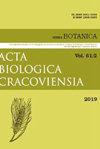Response of Gas Exchange to Leaf Piercing Explained by Piecewise Linear Regression for Two Developmental Forms of Rape Plant (Brassica napus L. ssp. oleifera Metzg) Series botanica
IF 0.4
4区 生物学
Q4 PLANT SCIENCES
引用次数: 1
Abstract
Oilseed rape (Brassica napus L. ssp. oleifera Metzg) was the subject of the study in two forms: winter cv. ‘Muller’ (at the rosette stage – the first internode BBCH 30 – 31) and spring cv. ‘Feliks’ (at the yellow bud stage BBCH 59). The main gas-exchange parameters, net photosynthetic rate (PN), transpiration rate (E), stomatal conductance (gₛ), and intercellular CO₂ concentration (Cᵢ) were measured on leaves prior to the piercing and immediately after the short-term piercing. The effect of mechanical wounding revealed different progress of the gas exchange process for the two forms. Piecewise linear regression with the breakpoint estimation showed that the plants at the same age but at a different vegetal stage, manage mechanical leaf-piercing differently. The differences concerned the stomatal conductance and transpiration changes since for rosette leaves the process consisted of five intervals with a uniform direction, while for stem leaves - of five intervals with a fluctuating direction. These parameters got stabilized within a similar time (220 mins) for both forms. The process of net photosynthetic rate was altered by the plant stages. ‘Muller’ plants at the rosette stage demonstrated dependence of PN on time in log-linear progression: y (PN) = 8.01 + 2.73 log₁₀ (x t₂); 7 < t₂ < 220; R² = 0.96. For stem leaves of ‘Feliks’ plants the process of transpiration, in terms of directions, was convergent with the process of photosynthesis. Those two processes were synchronized from 1ˢᵗ to 114ᵗʰ min of the test (r = 0.85; p < 0.001) in plants at the rosette stage and from 26ᵗʰ to 148ᵗʰ min in stem leaves (r = 0.95; p < 0.001).用分段线性回归解释两种发育形态油菜叶片刺穿过程中气体交换的响应植物科油橄榄属
油菜(Brassica napus L. ssp.)油橄榄(oleifera Metzg)是两种形式的研究对象:冬季cv。‘穆勒’(在莲座期-第一个节间bbch30 - 31)和春季cv。“Feliks”(黄花期BBCH 59)。测定了刺穿前和刺穿后叶片的主要气体交换参数净光合速率(PN)、蒸腾速率(E)、气孔导度(gₛ)和细胞间CO₂浓度(C ^ E)。机械损伤的作用揭示了两种形态气体交换过程的不同进展。采用断点估计的分段线性回归分析表明,同一树龄不同生长阶段的植株对机械刺叶的处理方式存在差异。这些差异涉及气孔导度和蒸腾的变化,因为莲座叶的过程由5个均匀方向的间隔组成,而茎叶的过程由5个波动方向的间隔组成。对于两种形式,这些参数在相似的时间(220分钟)内稳定下来。净光合速率的变化过程随植株生长阶段的不同而不同。“穆勒”植株在莲座期表现出PN与时间的对数线性关系:y (PN) = 8.01 + 2.73 log₁₀(x t₂);7 < t₂< 220;R²= 0.96。“费利克斯”植物茎叶的蒸腾过程在方向上与光合作用过程趋同。这两个过程在测试的1 ~ 114个小时内同步(r = 0.85;P < 0.001),茎叶26 ~ 148个单位(r = 0.95;P < 0.001)。
本文章由计算机程序翻译,如有差异,请以英文原文为准。
求助全文
约1分钟内获得全文
求助全文
来源期刊
CiteScore
3.00
自引率
0.00%
发文量
0
审稿时长
>12 weeks
期刊介绍:
ACTA BIOLOGICA CRACOVIENSIA Series Botanica is an English-language journal founded in 1958, devoted to plant anatomy and morphology, cytology, genetics, embryology, tissue culture, physiology, biochemistry, biosystematics, molecular phylogenetics and phylogeography, as well as phytochemistry. It is published twice a year.

 求助内容:
求助内容: 应助结果提醒方式:
应助结果提醒方式:


